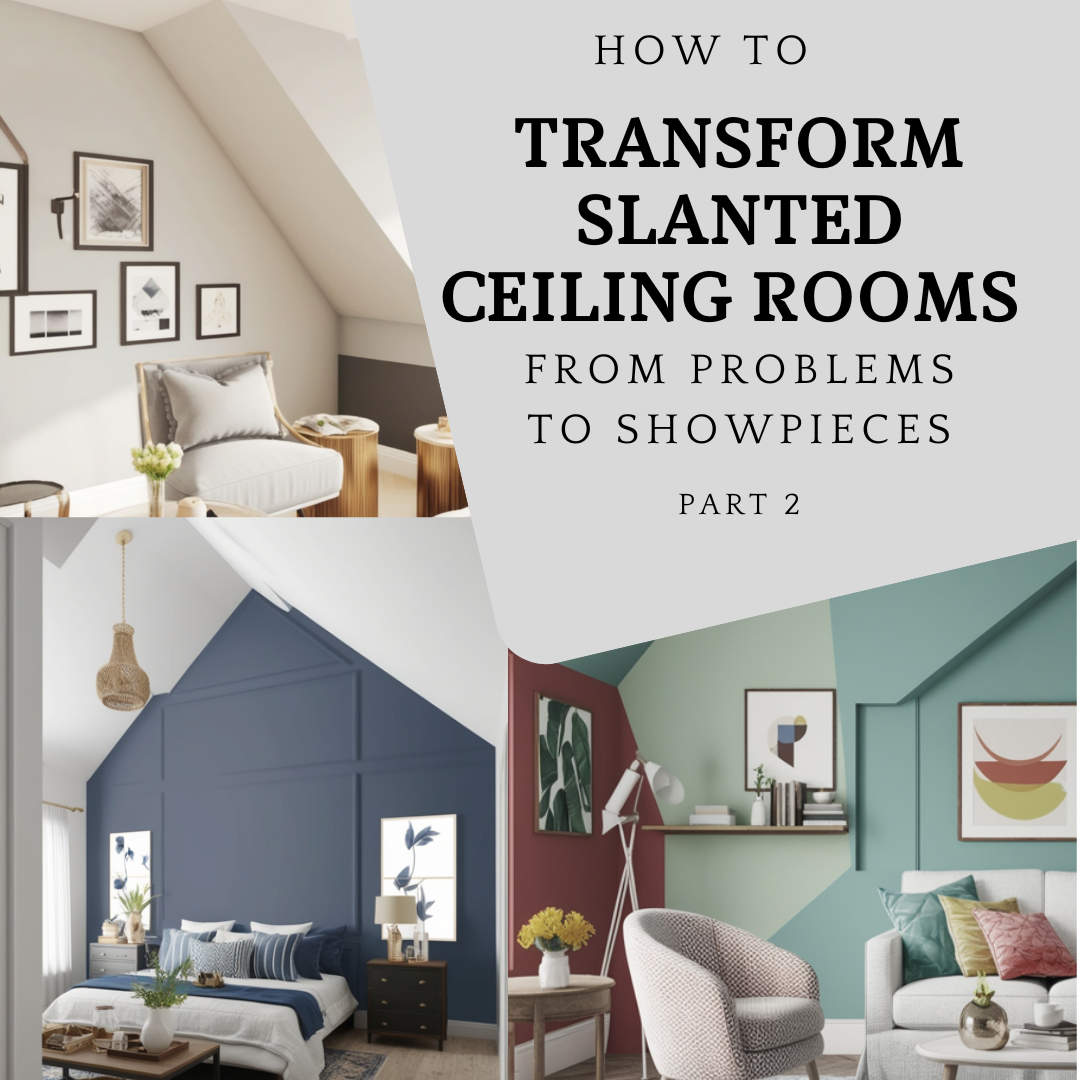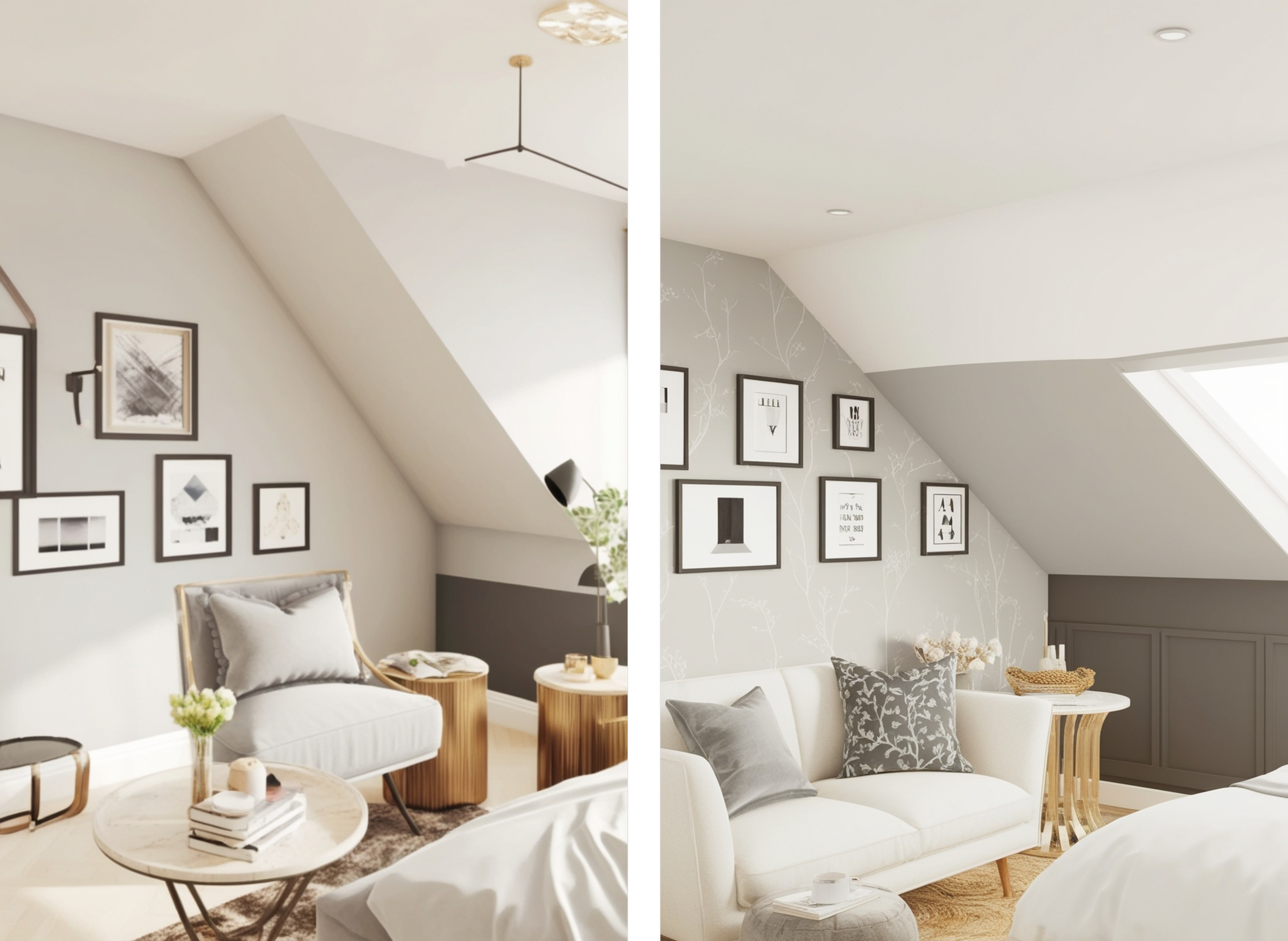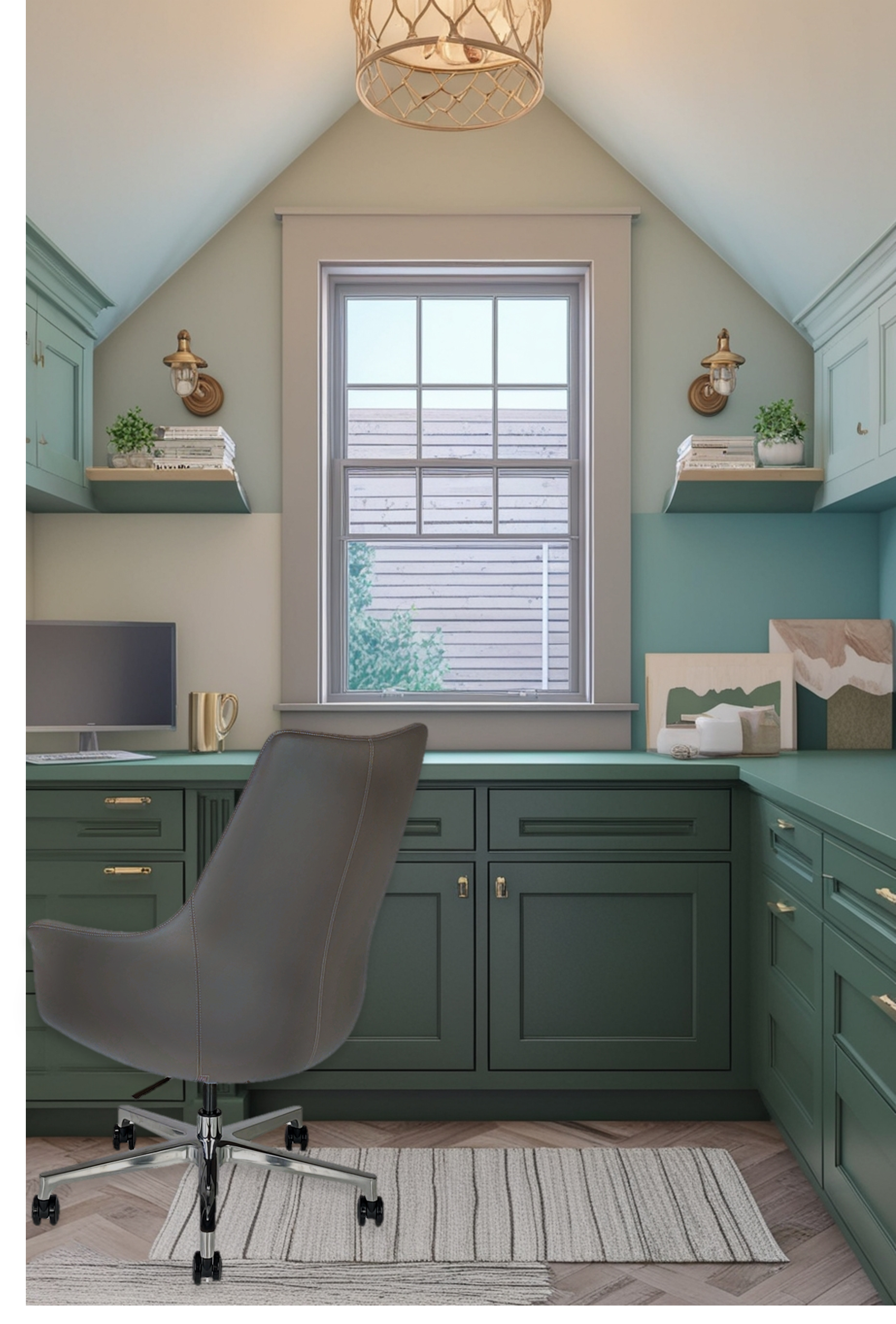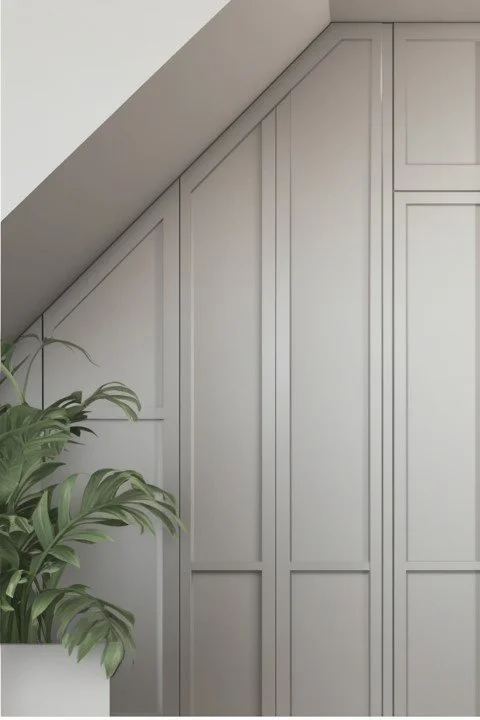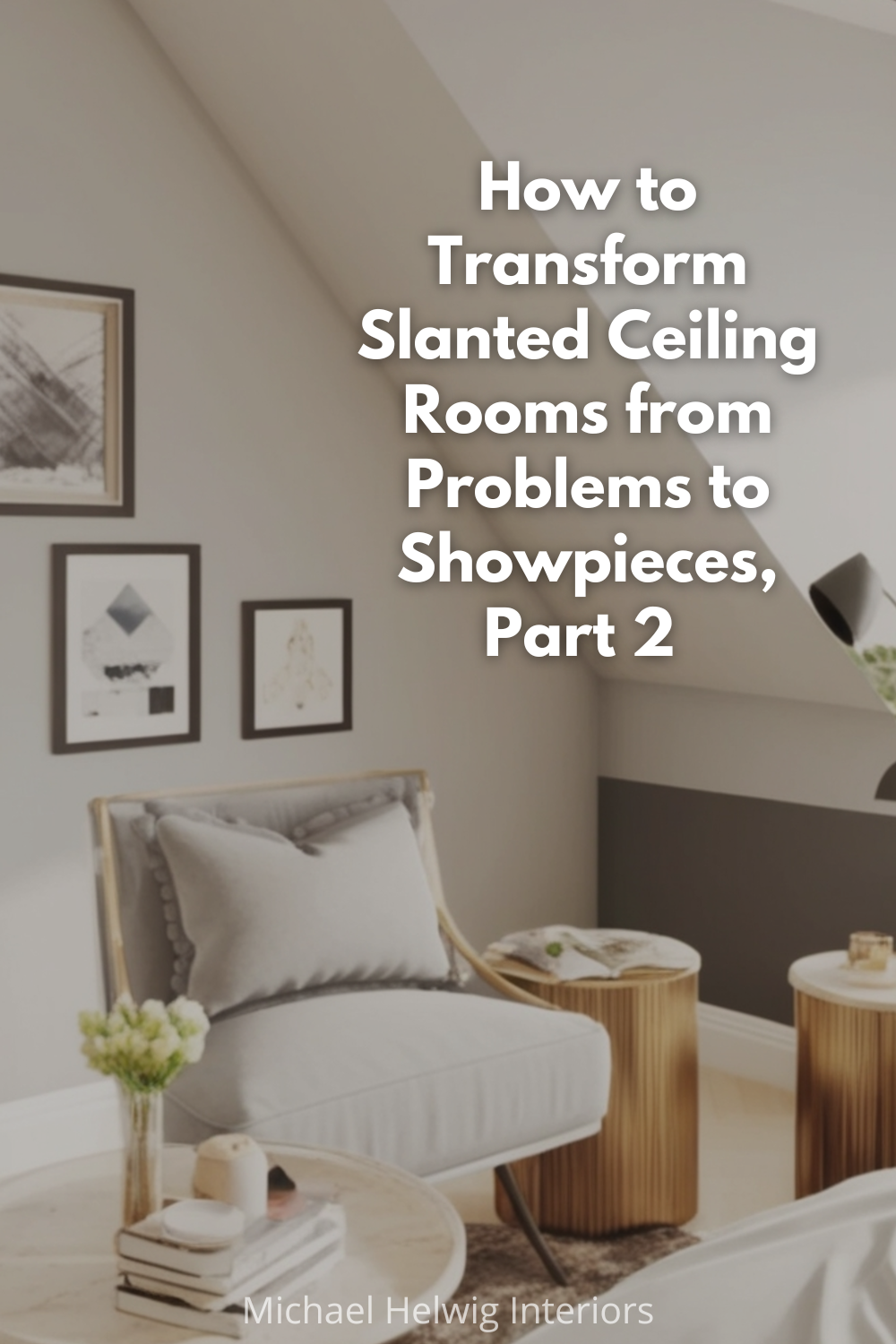Now that we've covered the foundation work – measuring your space, understanding what you're working with, and getting your lighting sorted – it's time for the fun stuff. This is where we stop just dealing with those slanted walls and start making them the reason people remember your room.
I know you might still be looking at those angles thinking "easier said than done," but trust me on this: the strategies we're diving into next are where the transformations get real! We're talking about color tricks that fool the eye, storage solutions that make you wonder why all rooms don't have slanted ceilings, and design moves that turn awkward into amazing.
The best part? Most of these don't require a contractor or a massive budget. Just a willingness to think differently about what makes a room work.
So, grab that room sketch you made earlier – you're going to need it. Let's turn those "problem" angles into the features they’re meant to be.
Section 5: Color and Visual Tricks That Work Magic
Wall color can completely transform how your slanted ceiling room feels. Some colors can make rooms with angles feel bigger and expensive, while other ones can emphasize every awkward spot.
Paint Strategies for Slanted Rooms
Color drenching involves using the same color on walls and ceiling. I mentioned it in part 1, but here’s why it works:
It creates a cocoon-like feeling that can be super cozy and sophisticated. Making everything the same color fools your eye into not seeing boundaries like the ceiling or wall angles. This is a great way to camouflage the bits you don’t love. It works with light wall colors and dark the same way.
The contrast approach uses different colors on walls versus ceiling or slanted areas.
This can work beautifully when done thoughtfully. For example, keeping walls neutral while painting the slanted ceiling a soft color draws the eye up and makes the angles front and center.
But be aware that this will also reinforce visual boundaries, so make sure the way you use it works to highlight and bring focus to what you want to focus on, like a focal wall where an impressive piece of furniture is layered in front of a contrasting-colored, angled wall.
Which brings me to the focal wall approach: making one angle the star, especially when that wall is the focus of the room - like a TV viewing wall or the wall behind your bed, for example.
Try painting this wall a bold color while keeping others neutral, and suddenly your slanted ceiling becomes a design feature rather than a problem. (This can work with a wallpaper application too.)
Colors That Open Up Angled Spaces
Light colors do maximize perceived space, but don't think you're limited to white.
Soft blues, warm grays, pale greens, and creamy neutrals can all make your room feel larger while adding more personality than stark white.
And like I mentioned before, dark colors can work great in slanted rooms when used strategically.
A deep, rich color on slanted areas can make them recede visually while creating some drama and sophistication. This works best in bedrooms where you want a cozy, intimate vibe. (Try the color washing technique from above if you want an even more vibey room…)
In a nutshell, use color to guide the eye toward your room's best features and away from any awkward angles you'd rather diminish.
Visual Tricks to Enhance Your Angles
Vertical line elements like tall, narrow artwork or vertical paneling can make low areas feel taller.
Horizontal line elements like wide furniture or horizontal artwork can make narrow spaces feel wider.
So, it’s best to refer to your room sketch before making final decisions so you can choose the best ways to add focus with vertical and horizontal lines.
Patterns and textures affect slopes in interesting ways.
Geometric patterns can emphasize angles (which might be good or bad depending on your goals), while organic patterns tend to soften them.
Textured walls can add focus without fighting the architecture. A lot of big box home stores sell wall texture kits, and you can use wallpaper to add dimension to walls too.
Mirror placement in slanted rooms requires some thought, but mirrors can work magically by reflecting light and making a space feel bigger.
Place them where they'll reflect the most natural light or interesting architectural features rather than awkward angles.
Tip: If you remember that mirrors double what they reflect, you’ll be able to place them with a more critical eye. Try asking another person to hold the mirror up in different spots to test the reflection it produces. Always aim for placing mirrors in spots that will reflect interesting things. Thinking through the placement will really amp up your room’s aesthetics.
Section 6: Window Treatments for Angled Windows
Windows in slanted ceiling rooms often present tricky challenges, but they're also opportunities to add some personal style and function.
Dormer Window Challenges
Standard curtain rods don't work well when windows are set into angled walls. The angles can make it really hard to hang curtains.
Custom solutions for oddly shaped windows might include angled curtain rods that follow the roofline or mounting hardware directly to the window frame rather than the wall and they look sophisticated when done right. This might mean custom panels or creative hanging solutions.
Creative Window Treatment Ideas
For many angled windows, simple shades or blinds mounted inside the window framework is better than trying to hang curtains around tricky angles. They provide privacy and light control without competing with the architecture.
Sometimes the best treatment for angled windows is no treatment at all. If the windows provide beautiful views or interesting light patterns, and privacy isn't a concern, leaving them bare is best.
Section 7: Storage Ideas That Work with Your Angles
One of the biggest advantages of slanted ceiling rooms? You can have unique storage opportunities that “regular” rooms don't have.
Built-In Storage Ideas
Under-eaves storage systems can hold tons of stuff while looking completely built-in. These areas are perfect for seasonal items, holiday decorations, or anything you don't need regular access to.
Custom closets for slanted rooms can maximize every inch of available space. Even if you're not ready for a full custom closet, simple additions like extra rods at different heights or pull-out drawers can make a huge difference.
Knee wall storage is often overlooked, but these short walls in slanted rooms are perfect for built-in shelving, drawers, or cabinets. They provide storage without interfering with the room's flow.
Furniture Storage Solutions
Storage ottomans and benches work great in low spots where other furniture won't fit. They provide seating and storage and help make those under-used areas more useful.
Modular shelving that can be installed at different heights to adapt to angled rooms. Look for systems where you can add or remove shelves and adjust heights as needed.
Get creative with baskets and bins in open storage areas. They keep things organized while adding texture and functionality to your slanted spaces.
Section 8: Room-by-Room Fixes
Let's get specific about how these principles work in different types of rooms.
Slanted Ceiling Bedrooms
Bed placement is crucial – You should put the headboard against the wall with the most ceiling height. This allows you to sit up in bed comfortably and creates better proportion in the room.
Creating functional bedside areas might mean using wall-mounted sconces instead of table lamps or choosing low nightstands that fit under slanted areas. Think about what you actually need within reach of your bed and plan accordingly.
Closet solutions for angled rooms often involve getting creative with hanging heights and storage types. You might have full-height hanging on one side and double rods or shelving on the slanted side.
Angled Living Spaces
Seating arrangements need to account for both ceiling height and conversation flow.
Place taller seating like sofas in higher spots
Use lower seating like floor cushions or ottomans in slanted areas.
Entertainment center placement should prioritize viewing angles and ceiling clearance.
Wall-mounting your TV might work better than a tall entertainment center.
Creating conversation areas in angled spaces often means using the angles to define different zones within the room.
Attic Office/Studio Spaces
Desk placement in low-ceiling areas can actually work well since you're sitting down anyway. Just make sure you have adequate lighting and can get in and out of your chair comfortably.
Storage for supplies and equipment needs to be accessible but not overwhelming in a slanted space.
Built-in shelving and hidden storage work better than lots of freestanding pieces.
Creating functional workspaces in angled wall rooms means embracing the cozy, creative feeling that slanted ceilings naturally provide. So, keep your room sketch handy when you’re shopping for things, so you get things that fit and add the functionality you need.
Section 9: Budget-Friendly vs. Splurge Fixes
Not every solution needs to break the bank, but some investments are worth making.
DIY Projects That Make a Big Impact
Simple built-ins like basic shelving or storage benches can be tackled by most DIYers and make a huge difference in how finished and personalized your space looks.
Paint projects are one of the biggest bang-for-your-buck improvements. Whether you're creating an accent wall or using color to enhance your angles, paint transforms spaces on the cheap.
Affordable lighting upgrades like new lamps, string lights, or updated fixtures can completely change how your angled room feels without major investment.
When to Invest in Professional Help
Complex built-in projects that require precise measurements and professional carpentry skills are worth hiring out. The difference between DIY and professional results is usually obvious with complicated built-ins.
Electrical work for angled lighting should always be done by professionals, especially if you're adding new circuits or moving fixtures.
Custom furniture might be worth the investment if you have unusual angles that make standard furniture shopping nearly impossible. Many stores can customize the size, scale, and depth of furniture so they’ll fit your tricky spaces best.
Conclusion: Quick Wins for Your Angled Room
Quick Wins You Can Start Today
Here are three immediate changes that make a difference:
First, rearrange your furniture to work with your angles instead of against them - move tall pieces to high-ceiling areas and embrace low-profile furniture in slanted areas.
Second, add lighting to dark corners and dead zones - even just a table lamp or string lights can make these areas feel finished and purposeful.
Third, choose one angle to highlight with color, artwork, or decor rather than trying to hide all of them.
Your shopping list for essential items might include: a few good table lamps for areas where overhead lighting won't work, some storage baskets or bins for organizing dead zones, and paint samples to test color ideas on your angled walls.
Long-Term Transformation Steps
Prioritize your improvements based on which issues bother you most and which solutions will have the biggest impact.
Start with lighting and furniture arrangement since these don't require major investment but make huge differences.
Plan bigger projects like built-ins or custom storage for later, once you've lived with your quick fixes and have a better sense of what your space really needs.
Final Inspiration
Here's what I want you to remember: those angles that frustrate you right now are actually what make your space special. Anyone can decorate a perfectly square room, but you have something unique and interesting to work with.
Your slanted ceiling room has character and possibilities that “standard rooms” don't have. Instead of seeing problems, start seeing potential.
Stop thinking about your angled walls as design obstacles – think of them as opportunities to create unique and personalized spaces! When you think about it that way, that "difficult" room might just become your favorite space in the house.
Share your slanted room stories with me in the comments below. Have you tried any of these tips or tricks? Are there others that worked even better? Ready to throw in the towel? Let’s talk about it. Share your frustrations too!
Read Next:
How to Transform Slanted Ceiling Rooms from Problems to Showpieces: A Complete Guide to Decorating Angled Spaces, Part 1
Slanted ceiling rooms driving you crazy? 🏠 You're not alone! I'm sharing all my best-kept secrets for furniture placement, genius lighting tricks, and storage solutions that actually work in awkward spaces. No more wrestling with where to put anything - this complete guide has room-by-room solutions that will transform your frustrating angles into stunning design features! Save this post and finally make peace with those tricky ceilings! ✨
Michael is Principal designer and blogger at Michael Helwig Interiors in beautiful Buffalo, New York. Since 2011, he’s a space planning expert, offering online interior e-design services for folks living in small homes, or for those with awkward and tricky layouts. He’s a frequent expert contributor to many National media publications and news outlets on topics related to decorating, interior design, diy projects, and more. Michael happily shares his experience to help folks avoid expensive mistakes and decorating disappointments. You can follow him on Pinterest, Instagram and Facebook @interiorsmh.

